For the determination of pharmacokinetic and pharmacodynamic (PK/PD) effects of new insulins and other anti-diabetic drugs exists a gold standard: the euglycemic, hyperinsulinemic glucose clamp. In a typical glucose clamp experiment is infused glucose at a variable rate, so that BG is "clamped" at a pre-determined target level. Thereby a drug-induced decline in blood glucose (BG) concentrations is prevented.
Thus, the glucose clamp is designed as a closed-loop system where BG is measured frequently. The two major factors for determining glucose infusion rates (GIR) are considered as the changes in BG and deviation of BG from the target level.
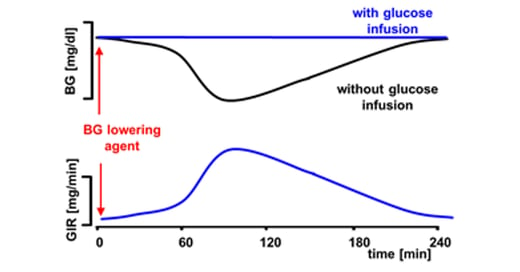
Figure 1
During automated glucose clamps artefacts like clotting, hardware problems etc. can lead to technical downtimes of several minutes without any new BG measurements and therefore no adapted GIRs. These downtimes might lead to fluctuations in both BG and GIR and thereby impact glucose clamp outcomes, potentially depending on the duration of the downtime period.
We therefore investigated the influence of technical downtimes of different duration on glucose clamp outcomes [1]. The duration of downtimes was described using the glucose clamp parameter utility, which is the percentage of operational time (with continuous BG measurements and automated GIR-adaptations) of the total duration of the clamp (i.e., the more technical downtimes, the lower the value for utility) [2].
Methods
According to the guidelines of the European Medicines Agency [3], the main PD-parameters to describe the BG-lowering effect of drugs are 'total area under the curve‘ (AUC), 'maximum GIR‘ (GIRmax) and 'time to maximum GIR‘ (tGIRmax).
AUC is the sum of GIRs during the whole clamp. GIRmax is the maximal point of the smoothed GIR-curve, tGIRmax the time from dosing to reach GIRmax (see figure 2). 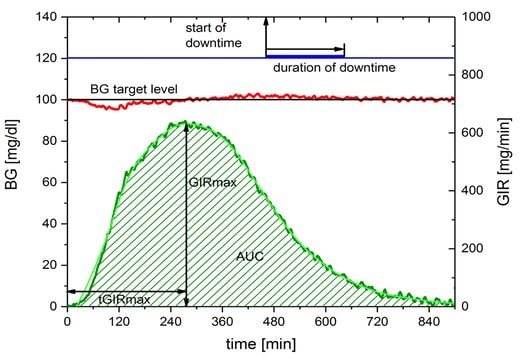
Figure 2
To investigate the influence of downtimes on the main PD parameters we simulated 100 clamps without disturbances and calculated AUC, GIRmax and tGIRmax for each of the clamps. Technical downtime, i.e. lower clamp utility was induced by suppressing the adaptation of GIR at predefined start times for predefined durations (see figure 3). For each combination of start time and duration, we simulated 100 clamps and calculated AUC, GIRmax and tGIRmax. The mean ratio of clamp-parameters between disturbed and undisturbed clamps was recorded for each combination.
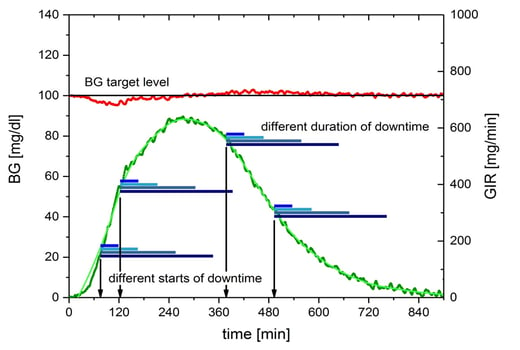 Figure 3
Figure 3
For the simulation of the glucose clamps we used a single compartment model with a BG decreasing effect by the insulin and an increasing effect by the administered GIR. Additionally some random noise was added to simulate the precision of the glucose sensor. The technical downtime was introduced by stopping the automated adaptation of the GIR. However, BG changes were calculated every minute as the simulated BG-lowering effect of the insulin continues but no new GIRs were calculated. We simulated continuous downtimes between 45 minutes (utility 95%) and 450 minutes (utility 50%). Start time was shifted in 10-minute steps from the beginning of a clamp. We assumed control measurements of BG and manual adaptations of GIR every 5 minutes during technical downtime. A simple algorithm for calculating manual GIR adaptations avoided operator bias. We chose an asymmetric algorithm to keep BG-values in physiological thresholds.
Results
The figures 4,5 and 6 show the influence of different durations of downtimes (utilities) on main PD outcome parameters.
Each point in the figures displays the mean change [%] in PD-parameters from the values determined in clamps without any downtime, which means a utility of 100%, in dependence of different utilities. The green horizontal lines show a threshold of ±5% considered as acceptable deviations from the PD outcome parameter obtained with 100% utility.
Figure 4 shows that AUC is quite robust to technical downtimes. Significant changes in AUC only occurred with utility values below 60%.
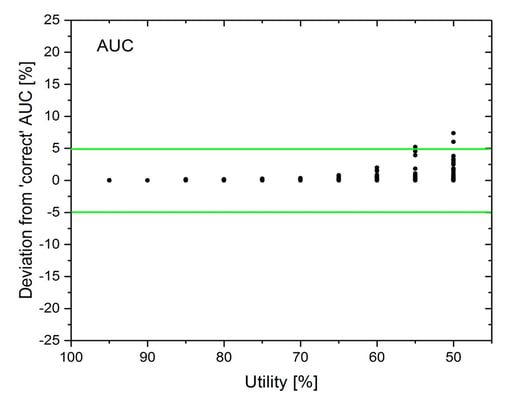
Figure 4
In contrast, for GIRmax significant differences between clamps with and without downtime already occurred in some, but not in all clamps with utilities equal or below 80%. Noteworthy, GIRmax was always higher in clamps with some technical downtime compared with clamps without downtime.
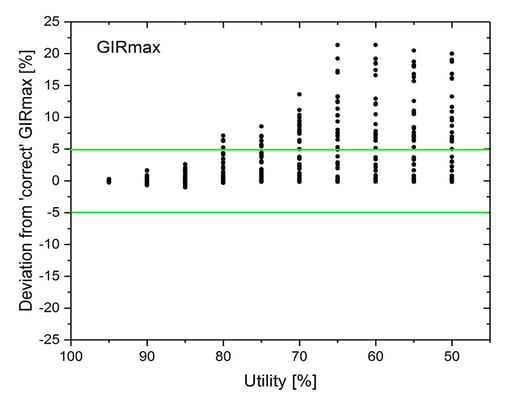
Figure 5
The most sensitive parameter for technical downtimes was tGIRmax, which showed significant changes already with clamp utility equal or below 90%.
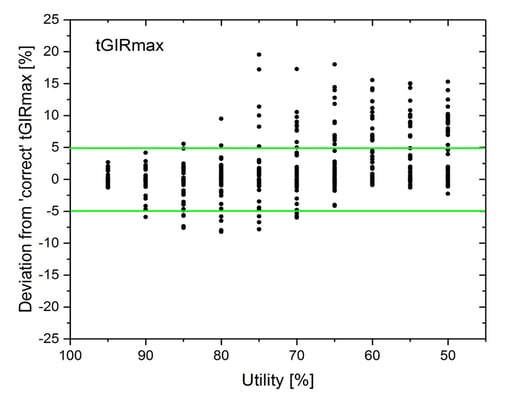
Figure 6
The table below summarizes the maximum deviation of the parameters AUC, GIRmax, tGIRmax with respect to the overall utility from 70% to 95%.
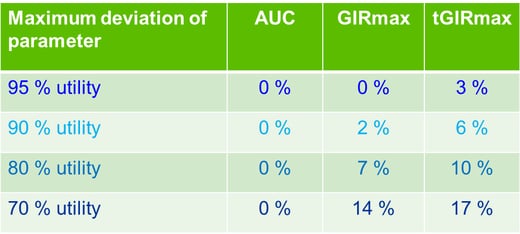
Conclusion and outlook
In automated clamps, the impact of technical downtime varied between PD-parameters:
For AUC, significant changes were only seen with utility values below 60%.
A higher impact of technical downtime was observed for other PD parameters, in particular tGIRmax, which was already significantly impacted with utility-values equal or below 90%.
Further investigations are ongoing to allow reliable predictions whether or not technical downtimes might have relevant impact on the measured PD-outcome parameters.
References
[1] Kuhlenkötter M, Heckermann S, Benesch C: Influence of Technical Down Time on the Outcome of Automated Glucose Clamps J Diabetes Sci Technol 12(2), A44, 2018




